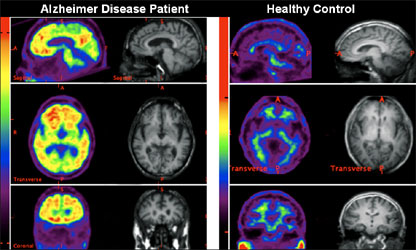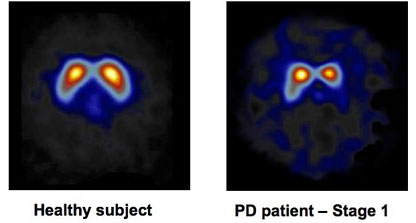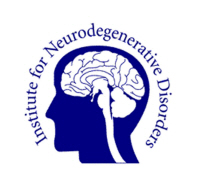TODO: INSERT BANNER IMAGE (~1500×800)
Brain Imaging
The primary goals of our PET and SPECT imaging studies
The development of innovative imaging techniques is a key feature of the research program at IND. Imaging research at IND focuses on functional imaging technology using Positron Emission Tomography (PET) and Single Photon Emission Computerized Tomography (SPECT) imaging. Using specific radioactively labeled molecules as tags or markers, in conjunction with PET or SPECT imaging offers the opportunity to view the neurochemical activity of the brain. Functional imaging with PET and SPECT imaging allows us to understand activity in the brain and subtle changes that may occur in early Alzheimer disease, Parkinson disease and other neurodegenerative conditions.
Improve Diagnosis Accuracy
Enable Earlier Diagnosis
Evaluate and Monitor Disease Severity
Quantify the Effect of Medications
Identify Neurochemical Changes Occurring with Neurodegeneration

Imaging in Alzheimer Disease
Functional imaging has recently emerged as a critical tool in understanding changes in the brain of individuals with memory loss and problems with thinking. Functional imaging using FDG PET has been available for several years and provides information about the metabolisms of the specific areas of the brain. FDG PET can be especially useful in differenting a diagnosis of Alzheimer disease from frontotemporal dementia.
A major advancement in Alzheimer disease research has been the development of amyloid imaging. It is well recognized that individuals with Alzheimer disease have an accumulation of a protein called amyloid in the brain. Several therapies aimed at slowing the progression of Alzheimer disease by reducing amyloid deposition are being testing in clinical trials. Imaging to detect amyloid in the brain is available in research settings and provides information that is used in conjunction with clinical evaluations. Amyloid imaging may be useful in clarifying a diagnosis of Alzheimer disease and differentiating this from other forms of dementia.
An example of amyloid imaging is provided in the figure below. In this figure, there is increased activity (bright red and yellow) in the patient with Alzheimer disease representing the presence of amyloid in the brain compared to relatively no activity in the healthy control image.

Imaging in Parkinson Disease
Over the past decade researchers at IND have developed and utilized dopamine transporter imaging in several studies to evaluate the diagnosis and monitor progression of Parkinson disease. In our studies, dopamine transporter imaging using [123I] ß-CIT SPECT discriminated between individuals with Parkinson disease and healthy subjects with a sensitivity of about 98%.
The figure below is an example of an image using [123I] ß-CIT SPECT in a patient with Parkinson disease and a healthy control. In this figure, the striatum, the area of the brain most affected by Parkinson disease, shows less uptake of [123I] ß-CIT in the Parkinson patient compared to the healthy control subject.
In addition to dopamine transporter imaging, several other imaging modalities evaluating neurochemical systems are under development. Neurochemical changes other than dopamine may be responsible for the non-motor symptoms of Parkinson disease including depression, anxiety, sleep difficulties and change in cognition. Understanding these neurochemical changes in the brain offers the opportunity to develop medications to improve both the motor and non-motor symptoms that occur in Parkinson disease.
